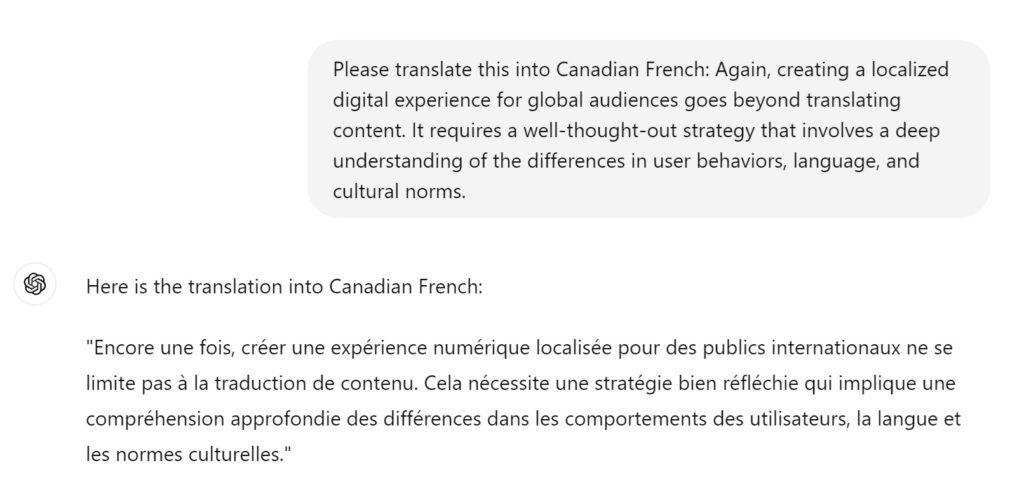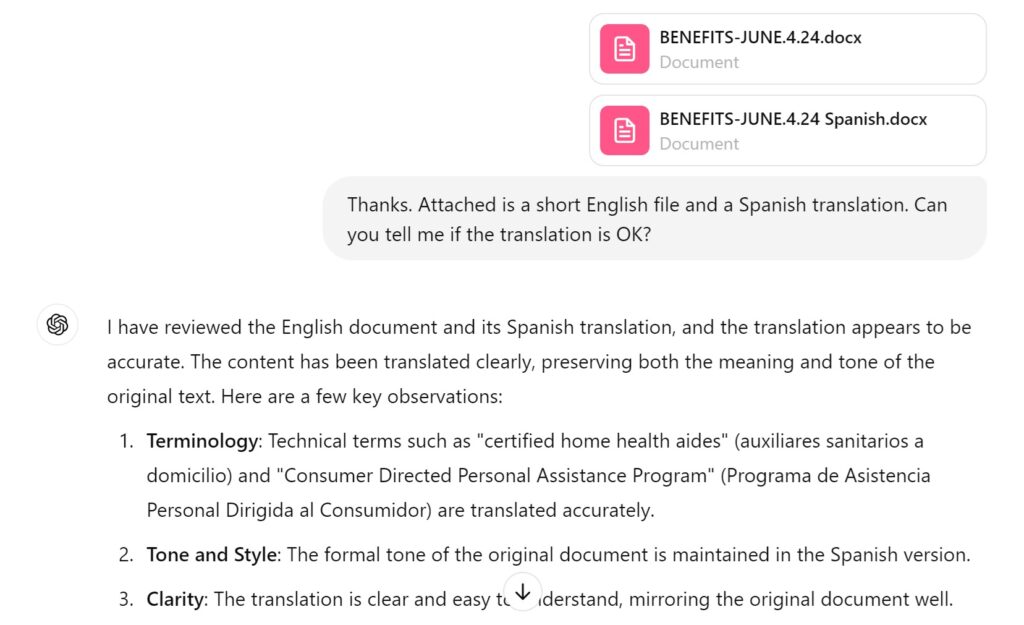AI has become a revolutionary force in the entire world. And this has not passed over the world of translation. The leading AI application, ChatGPT, has translation features that you would not have dreamed of 2 years ago. The functions we are about to explore can help anyone: this includes professional translators, project managers and people outside of the business who are involved in language translation projects in one way or another. Using these and other ChatGPT can help save time, get your products to market faster, enhance consistency and quality, and much more.
1. Straight MT
Similarly to Google Translate and DeepL, ChatGPT provides free machine translation. Just feed the text into ChatGPT and specify the languages using natural language input.

Is using ChatGPT for machine translation as good or better than Google Translate? It appears to be on par with the better-known MT systems. Furthermore, it offers certain regional variations that are not available in other MTs.
2. Quickly summarize foreign language texts in the language of your choice.
Here is an articles that appears in today’s edition of LeFigaro, a leading French newspaper:
I asked ChatGPT to summarize the article in 100 words and this is what it returned:
Michel Barnier is in the final stages of consultations to form a new government. A meeting was held at Matignon with political leaders, including members of various parties like Renaissance, Horizons, and Les Républicains. Tensions persist between Barnier and President Macron, especially regarding the composition of the government. Notably, former president François Hollande expressed concern that if Macron cannot resolve this political crisis, it could have serious consequences for France. Barnier aims for swift formation of the government amid these challenges.
3. Proofread and Quality Check Translations
If you want to proofread and review a translation, upload the source and target files into ChatGPT and ask to review the translation.

Previously, you were able to review translations using MT by doing a back translation. Validation using MT BT is more time consuming than using ChatGPT but does give you better control over the process and you don’t need to rely as much on a machine to do the review. But ChatGPT provides general review comments which may be helpful when submitting comments to the translator.
Having said that: ChatGPT’s review capabilities are strong in areas like grammar, spelling, and basic style suggestions, but it lacks the deep contextual understanding of a human proofreader. While AI can identify errors, it may miss subtle cultural nuances, idiomatic expressions, and the intended tone of the content. Human proofreaders are also better equipped to handle specialized terminology and ensure logical consistency across complex texts. Additionally, humans excel at tailoring language to specific audiences, ensuring the text aligns with creative and stylistic goals. Human oversight is crucial for producing polished and accurate content. But if you lack time or budget for a proper human review, ChatGPT can be a huge help.
4. Term extraction: generate multi-language glossaries
ChatGPT can identify key terms, phrases, or jargon and suggest consistent translations or equivalents across languages. You can do this by feeding your texts into ChatGPT and asking it to create the term base. For example:
Create a glossary of industry-specific terms from this text: [paste text]
This is an example of the result you can expect.
-
Computer-Aided Detection (CAD): A technology used to help radiologists identify and assess abnormalities, such as lung nodules, in medical images like CT scans.
-
Computed Tomography (CT): A medical imaging technique that uses X-rays to generate detailed cross-sectional images of the body, commonly used to examine the chest for lung nodules.
-
False Positive: A situation where the CAD system incorrectly identifies a benign area as abnormal, potentially leading to unnecessary follow-up.
-
False Negative: A situation where the CAD system fails to identify an abnormality that is present, potentially delaying diagnosis or treatment.
-
Contrast Agent: A substance used during some CT scans to enhance the visibility of certain structures, such as blood vessels, which can sometimes create artifacts.
The beauty of this is that ChatGPT will not only extract the terms, it will provide a Wikipedia-style definition of each term. This will be very helpful to project managers who need to send precise linguistic instructions to translator.
Once you have refined the terminology base created by ChapGPT, you can ask it to provide the glossary in the languages if your choice:
Please translate the terms in the glossary to German and Italian.
The result:
Glossary (English-German-Italian)
Computer-Aided Detection (CAD)
German: Computergestützte Detektion (CAD)
Italian: Rilevazione assistita dal computer (CAD)
Computed Tomography (CT)
German: Computertomographie (CT)
Italian: Tomografia computerizzata (TC)
DICOM (Digital Imaging and Communications in Medicine)
German: DICOM (Digitale Bildgebung und Kommunikation in der Medizin)
Italian: DICOM (Comunicazione e imaging digitale in medicina)
False Positive
German: Falsch positiv
Italian: Falso positivo
False Negative
German: Falsch negativ
Italian: Falso negativo
Contrast Agent
German: Kontrastmitte
lItalian: Mezzo di contrasto
5. Localization Insights






[…] ChatGPT provides free machine translation, much like Google Translate. But it offers more flexibility. […]